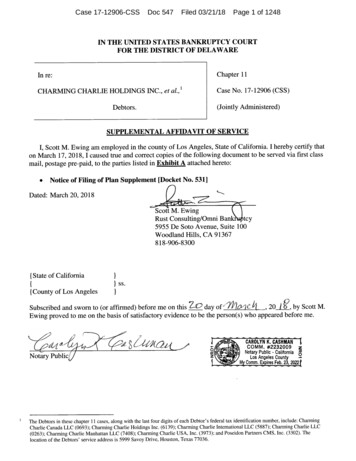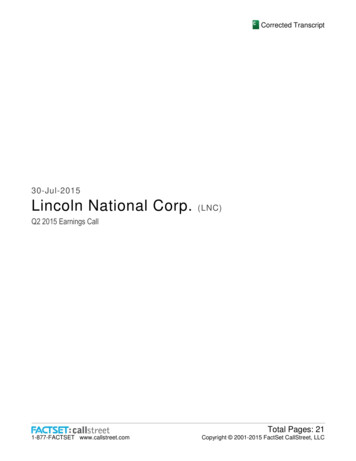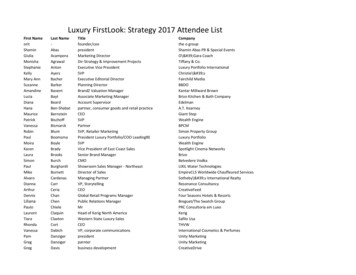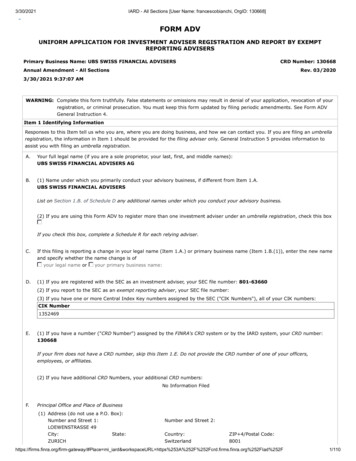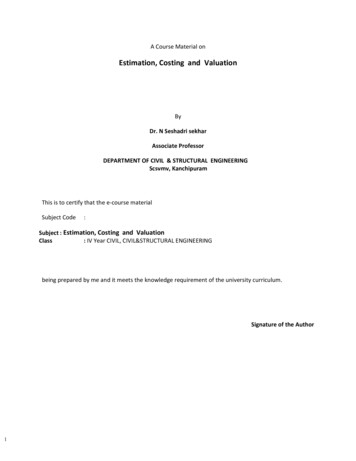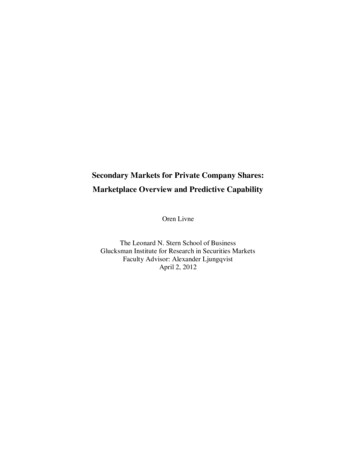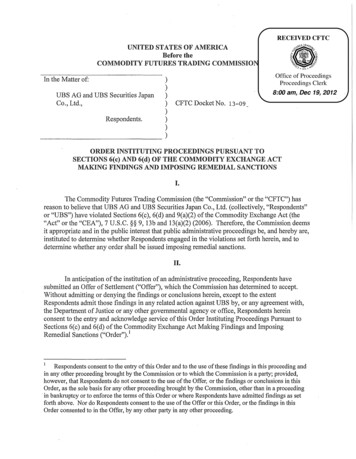
Transcription
RECEIVED CFTCUNITED STATES OF AMERICABefore theCOMMODITY FUTURES TRADING COMMISSIONIn the Matter of:UBS AG and UBS Securities JapanCo., Ltd.,Respondents.)))))))Office of ProceedingsProceedings Clerk8:00 am, Dec 19, 2012CFTC Docket No. 13-09)ORDER INSTITUTING PROCEEDINGS PURSUANT TOSECTIONS 6(c) AND 6(d) OF THE COMMODITY EXCHANGE ACTMAKING FINDINGS AND IMPOSING REMEDIAL SANCTIONSI.The Commodity Futures Trading Commission (the "Commission" or the ''CFTC") hasreason to believe that UBS AG and UBS Securities Japan Co., Ltd. (collectively, "Respondents"or "UBS") have violated Sections 6(c), 6(d) and 9(a)(2) ofthe Commodity Exchange Act (the"Acf' or the "CEA"), 7 U.S.C. §§ 9, 13b and 13(a)(2) (2006). Therefore, the Commission deemsit appropriate and in the public interest that public administrative proceedings be, and hereby are,instituted to determine whether Respondents engaged in the violations set forth herein, and todetermine whether any order shall be issued imposing remedial sanctions.II.In anticipation of the institution of an administrative proceeding, Respondents havesubmitted an Offer of Settlement ("Offer"), which the Commission has determined to accept.Without admitting or denying the findings or ;onclusions herein, except to the extentRespondents admit those findings in any related action against UBS by, or any agreement with,the Department of Justice or any other governmental agency or office, Respondents hereinconsent to the entry and acknowledge service of this Order Instituting Proceedings Pursuant toSections 6(c) and 6(d) of the Commodity Exchange Act Making Findings and ImposingRemedial Sanctions ("Order"). 1Respondents consent to the entry of this Order and to the use of these findings in this proceeding andin any other proceeding brought by the Commission or to which the Commission is a party; provided,however, that Respondents do not consent to the use of the Offer, or the findings or conclusions in thisOrder, as the sole basis for any other proceeding brought by the Commission, other than in a proceeding·in bankruptcy or to enforce the terms of this Order or where Respondents have admitted findings as setforth above. Nor do Respondents consent to the use of the Offer or this Order, or the findings in thisOrder consented to in the Offer, by any other party in any other proceeding.
III.The Commission finds the following:A.SummaryFor more than six years, since at least January 2005, UBS, by and through the acts ofdozens of employees, officers and agents located around the world, engaged in systemicmisconduct that undermined the integrity of certain global benchmark interest rates, including,but not limited to, the London Interbank Offered Rate ("LIBOR") for certain currencies, the EuroInterbank Offered Rate ("Euribor") and the Euroyen Tokyo Interbank Offered Rate ("EuroyenTIBOR"), that are critical to international financial markets.UBS engaged in two overarching courses of misconduct. First, from at least January2005 to at least June 2010, UBS made knowingly false submissions to rate-fixing panels tobenefit its derivatives trading positions or the derivatives trading positions of other banks inattempts to manipulate Yen, Swiss Franc, Sterling and Euro LIB OR and Euribor, and,periodically, Euroyen TIBOR. UBS, through certain derivatives traders, also colluded withtraders at other banks and coordinated with interdealer brokers in its attempts to manipulate YenLIBOR and Euroyen TIBOR. For certain currencies and benchmark interest rates, this conductoccurred on a regular basis and sometimes daily. UBS was, at times, successful in its attempts tomanipulate Yen LIBOR.Second, from approximately August 2007 to mid-2009, UBS, at times, used falsebenchmark interest rate submissions, including U.S. Dollar LIBOR, to protect itself againstmedia speculation concerning its financial stability during the financial crisis.Manipulative Conduct for ProfitThroughout the period, UBS routinely skewed its submissions to interest rate-fixingpanels for Yen, Swiss Franc, Sterling and Euro LIBOR and Euribor and, at times, EuroyenTIBOR, to benefit UBS's derivatives trading positions that were tied to those particularbenchmarks. UBS used a flawed submission process that relied on inherently conflictedemployees to make submissions. UBS made derivatives traders responsible not only for tradingtheir derivatives books for a profit, but also for determining UBS's benchmark interest ratesubmissions. As a result, when determining the rates to submit to the official panels, UBS'ssubmitters for these currencies and benchmarks often took into consideration how thesubmissions might benefit their trading positions. These UBS submitters also accommodatedrequests of other UBS derivatives traders for submissions that would be beneficial to theirtrading positions, by either maximizing their profits or minimizing their losses. (see pp. 10-37for Yen LIBOR andEuroyen TIBOR, p .38 for Swiss Franc LIBOR, pp. 38-39 for SterlingLIBOR, and pp. 39-41 for Euro LIBOR and Euribor, infra.)This profit-driven conduct spanned from at least January 2005 through June 2010 and, attimes, occurred on an almost daily basis. It involved more than three dozen traders andsubmitters located in multiple offices, from London to Zurich to Tokyo, and elsewhere. The2
misconduct included several UBS managers, who made requests to benefit their tradingpositions, facilitated the requests of their staff for submissions that benefited their tradingpositions, or knew that this was a routine practice of the traders and did nothing to stop it. UBStraders inappropriately viewed their benchmark interest rate submissions, such as UBS's LIBORsubmissions, as mere tools to help the traders increase the profits or minimize losses on theirtrading positions. To be sure, UBS's benchmark interest rate submissions frequently were not areflection ofUBS's assessment of the costs ofbonowing funds in the'relevant interbank markets,as each ofthe benchmark definitions required.In this environment, UBS, primarily through the acts and direction of a senior Yenderivatives trader, orchestrated a massive, multi-year course of unlawful conduct to manipulateYen LIB OR on, at times, an almost daily basis and, periodically, Euroyen TIBOR. This seniorYen trader, known as one of the largest traders in the entire Yen market, took on significant,high-risk derivatives trading positions that generated hundreds of millions of dollars for UBS.He implemented at least three manipulative strategies, which he often used simultaneously toincrease the likelihood that he would be successful: (i) he had UBS Yen LIB OR and EuroyenTIBOR submitters make submissions for particular maturities ("tenors") reflecting his prefenedrates (see pp. 12-17, infra.); (ii) he cultivated prior working relationships and friendships withderivatives traders from at least four other banks and had them make requests of their YenLIBOR submitters based on his preferred rates (see pp. 17-20, infra.); and (iii) he used at leastfive interdealer brokers, who intermediated cash and derivatives transactions for clients,including other banks that made benchmark interest rate submissions, to disseminate falsemarket information relating to Yen LIBOR to multiple panel banks in order to impact theirsubmissions to his benefit. (see pp. 20-29, infra.)The UBS senior Yen trader had the interdealer brokers utilize various methods to try toaffect the submissions of other banks, including: (i) disseminating false "run-throughs" ofsuggested Yen LIBOR to many, if not all, ofthe panel banks (see pp. 22-24, infra.); (ii)contacting directly other banlc submitters (see pp. 24-26, infra.); (iii) publishing false marketcash rates over certain dedicated electronic screens available to clients (seep. 26, infra.); and (iv)"spoofing" or making fake bids and offers, all tailored to drive the submissions of the otherbanlcs to the rates that benefited the senior Yen trader's derivatives positions. (see pp. 26-27,infra.) To secure the cooperation of the brokers and, at times, other derivatives traders, thesenior Yen trader found ways to compensate them, including by executing additional trades orwash trades to generate commissions for the brokers and by negotiating an extra UBS-paid fee orbonus to one interdealer broker, totaling about 216,000 over ah approximately two-year period.UBS, through the senior Yen trader and others, made approximately 2,000 writteninternal and external requests in attempts to manipulate Yen LIBOR in just a three-year period,accounting for 75% ofthe days in which Yen LIBOR submissions were made by UBS duringthat period? Sometimes, the senior Yen trader sought to manipulate particular tenors on one2For purposes of this Order, the term "request" means a request for a preferential submission for a·particular tenor. For example, if a UBS derivatives trader asked a UBS submitter that preferential rates besubmitted for three tenors, then the Commission views that as constituting three separate requests madeon that particular day.3
day, and sometimes he looked ahead and conducted sustained manipulative operations for weeksto move Yen LIBOR in the direction he needed, even coining names for these longer-termschemes, such as "the Turn Campaign" and "Operation 6m." (see pp. 29-36 infra). At times,UBS was successful in its attempts to manipulate Yen LIBOR for certain tenors.UBS, through certain Yen traders, continued to use these strategies to attempt tomanipulate Yen LIBOR and Euroyen TIBOR, even after the senior Yen trader departed UBS inlate 2009, as UBS managed the massive trading positions he had accumulated for the firm:False Reports to Protect ReputationDuring the financial crisis, certain UBS managers issued directions for making UBSbenchmark interest rate submissions in order to protect against what UBS perceived as unfair andinaccurate negative public and media perceptions about UBS. UBS first directed that UBS'ssubmissions should "err on the low side" of the panel banks' submissions, a direction itssubmitters generally followed. UBS subsequently directed that UBS's submissions be "in themiddle of the pack" ofthe panel banks' submissions, and the submitters followed the directionagain. These directions at times improperly influenced submissions for U.S Dollar LIB OR, aswelJ as LIBORs for other currencies, and Euribor and Euroyen TIBOR, and at times resulted insubmissions that did not solely reflect UBS 's assessment of the borrowing costs of unsecuredfunds in the relevant interbank markets, as required. At times, these directions resulted in UBSknowingly making false, misleading or knowingly inaccurate LIBOR, Euribor and EuroyenTIBOR submissions from early August 2007 to at least mid-2009. (see pp·. 41-52, infraiA bank's concerns about its reputation, negative market or press reports, or its tradingpositions and related profits are not legitimate or permissible factors upon which a bank maybase its daily benchmark interest rate submissions. Benchmark interest rate submissions conveymarket information aboutthe costs of borrowing unsecured funds in particular currencies andtenors, the liquidity conditions and stress in the money markets and a banlc's, such as UBS'sability to borrow funds in the particular markets. By basing its submissions, in whole or in part,on UBS's trading positions and at times its reputational concerns, UBS knowingly conveyedfalse, misleading or knowingly inaccurate reports that its submitted rates for LIBOR, Euribor,and Euroyen TIBOR were based on and solely reflected the costs of borrowing unsecured fundsin the relevant interbanlc markets and were truthful and reliable. Thus, UBS's false submissionscontained market information that affected or tended to affect LIBOR, Euribor and EuroyenTIBOR, commodities in interstate commerce.The Conduct Continued After UBS Was on Notice of the CFTC InvestigationUBS continued to engage in all of the conduct described above, particularly the tradermanipulative conduct, long after it was on notice that the CFTC was investigating UBS inconnection with its U.S. Dollar LIBOR practices. UBS received a demand for documents andThese directions to be "in the middle of the pack," by definition, resulted in UBS's submissions attimes being part of the calculation of the official published LffiOR. However, the Commission has notfound evidence that UBS issued or acted upon the directions with the intent to manipulate the officialpublished LIDOR for any currency or other benchmark interest rates.4
information from the CFTC's Division of Enforcement in October 2008; yet the conduct of thetraders and submitters, including the collusive conduct, occurred well into 2010. The rampantmisconduct across benchmarks at UBS only came to light as a result of the CFTC's subsequentrequest in April2010 that UBS conduct an internal investigation relating to its U.S. DollarLIBOR practices.***************Commencing in or about late December 2010, Respondents provided substantialassistance to the Division of Enforcement in its investigation, including information and analysis.In accepting UBS's Offer, the Commission recognizes Respondents' cooperation as of lateDecember 2010.B.RespondentsUBS AG is a Swiss banking and financial services company headquartered in Zurich andBasel, Switzerland that provides investment banking, asset management and wealth managementservices for private, corporate and institutional clients worldwide. It has operations in over 50countries, including the United States. The Investment Banking division ofUBS is responsiblefor making submissions for benc]:unark interest rates.UBS Securities Japan Co., Ltd. is the successor company to UBS Securities Japan, Ltd.,which, at all times during the periods covered by this Order, was a wholly-owned subsidiary ofUBS AG and engaged in investment banking operations and was a securities broker-dealer. Ithad a branch office in Tokyo, Japan.C.Facts1.UBS Made False Reports and Attempted to Manipulate LIBOR and OtherBenchmark Interest Rates, at Times Successfully, to Benefit UBS'sDerivatives PositionsFrom at least January 2005 through at least June 2010, UBS, through the acts of itsderivatives traders, benchmark interest rate submitters and managers, made false benchmarkinterest rate submissions in an effort to manipulate the official fixings of Yen, Swiss Franc,Sterling and Euro LIBOR, Euribor and Euroyen TIBOR. The goal was simple: to profit. UBSheld significant derivatives positions whose value depended on benchmark interest rates fixed byrate-setting panels. As more fully described below, the panels fixed and issued the respectivebenchmarks based on rates submitted by banks on the respective panels, such as UBS, that weresupposed to reflect an assessment of the costs of borrowing unsecured funds in the relevantinterbank money markets. UBS, however, made false submissions intended to manipulate these. benchmarks to make its derivatives positions more profitable or to minimize losses.Interest rate swaps traders ("Derivatives Traders"), located in UBS's London, Zurich andTokyo offices, routinely asked their UBS colleagues who determined UBS's submissions tomake certain submissions to affect the daily fixings for certain tenors of various LIB OR5
currencies, Euribor and, at times, Euroyen TIBOR. The Derivatives Traders' purpose was tobenefit their respective derivatives trading positions. The UBS submitters often based theirsubmissions on the traders' requests. Making matters even worse, for most of the period, untilapproximately September 2009, UBS's submitters wore two "hats"- they were also derivativestraders themselves ("Trader-Submitters") - and they also based UBS' s submissions on their owndesk's trading positions.Accordingly, throughout the six-year period, UBS, through its Trader-Submitters andothers, made benchmark interest rate submissions as set forth below reflecting rates thatbenefitted UBS's derivatives trading positions, rather than their assessment of the costs ofborrowing funds in the relevant markets. As detailed below, for certain benchmark interest ratesubmissions, this occurr-ed on an almost daily basis. The conduct of the dozens of DerivativesTraders and Trader-Submitters occurred openly and was pervasive at UBS on certain tradingdesks, even involving the participation or lmowledge of desk managers and senior managers. 4a. The Fixing of BBA LIBOR, EBF Euribor and JBA Euroyen TIBORLIB OR and its FixingLIB OR is the most widely used benchmark interest rate throughout the world. LIBOR isintended to be a barometer to measure strain in money markets and is often a gauge of themarket's expectation of future central bank interest rates. Approximately 350 trillion ofnotional swaps and 10 trillion of loans are indexed to LIBOR. LIBOR also is the basis forsettlement of interest rate futures and options contracts on many ofthe world's major futures andoptions exchanges, including the one-month and three-month Eurodollar futures contracts on theChicago Mercantile Exchange ("CME"). Moreover, LIBOR is fundamentally critical tofinancial markets and has an enormously widespread impact on global markets and consumers.Daily LIBORs are issued on behalf of the British Bankers' Association ("BBA"i for tencurrencies, including Yen, Sterling, Euro and Swiss Franc, with fifteen tenors ranging fromovernight through twelve months. According to the BBA, LIBOR "is based on offered interbanl : deposit rates contributed in accordance with the Instructions to BBA LIBOR Contributorbanks." The BBA requires that:4The term "Senior Manager" generally references UBS employees with responsibilities (either. formally or informally delegated) broader than management of trading desks, although theirresponsibilities may have at times included managing trading desks. The term "Senior Manager" does notinclude executive managers or the board of directors ofUBS.The BBA is a United Kingdom trade association for the United Kingdom banking and financialservices sector and is comprised of member banks. The BBA is not regulated.6
"[a]n individual BBA LIBOR Contributor Panel Bank will contribute the rate atwhich it could borrow funds, were it to do so by asking for and then acceptinginter-bank offers in reasonable market size just prior to [11 :00 a.m. Londontime]." 6Every business day shmily before 11 :00 a.m. London time, the banks on the LIBORpanels submit their rates to Thomson Reuters. A trimmed averaging process is used to excludethe top and bottom qua1iile of rates and then average the remaining rates for each currency andtenor. That average rate becomes the official BBA daily LIBOR (the "LIBOR fixing"). TheBBA then makes public the daily LIBOR fixing for each currency and tenor, as well as the dailysubmissions of each panel bank, through Thomson Reuters and the other data vendors licensedby the BBA. This information is made available and relied upon by market participants andothers around the world, including in the United States.Euribor and its FixingEm·ibor is the predominant money market reference interest rate for the Eurocurrencyand is used internationally in derivatives contracts, including interest rate swaps and futurescontracts. 7 At the end of2011, according to the Bank for International Settlements ("BIS"),over-the-counter interest rate derivatives in the Eurocurrency, such as swaps and forward rateagreements ("FRAs"), comprised contracts worth over 220 trillion in notional value. Euribor isfixed every business day for fifteen tenors, ranging from one week to twelve months.Euribor is defined by the European Banking Federation (''EBF") 8 as the rate "at whichEuro interbank term deposits are offered by one prime bank to another prime banlc" within theEconomic and Monetary Union of the European Union at 11:00 a.m. Central European Time("CET") daily. According to the EBF instructions, panel banlcs "must quote the required eurorates to the best of their knowledge." The panel banlcs are to observe the market and base theirsubmissions on where the Euro is trading in that market.The daily official fixing of EBF Euribor ("Euribor fixing") is also calculated based on atrimmed averaging methodology. On behalf ofEBF, Thomson Reuters issues the daily Euriborfixing and the submissions of each panel banlc to its subscribers and other licensed data vendors.Through these licensing agreements, this information is made available and relied upon bymarket participants and others around the world, including in the United States.6This definition ofLIBOR has been used by the BBA from 1998 to the present.In October 2011, the CME launched the Euribor Futures contract, which settles based on the threemonth Euribor.The EBF, an unregulated non-profit association of the European banking sector based in Brussels,Belgium, oversees the publication of Euribor.7
Euroyen TIBOR and its FixingEuroyen TIBOR is used internationally in derivatives contracts, including interest rateswaps and futures contracts on exchanges around the world, including the CME's EuroyenTIBOR futures contract. 9 Yen traded in a money market outside of Japan is referred to asEuroyen. Euroyen TIBOR reflects the prevailing money market rates in the Japan offshoremarket. At the end of2011, according to the BIS, over-the-counter interest rate derivatives inthe Yen currency, such as swaps and FRAs, comprised contracts worth over 66 trillion innotional value referenced to Yen rates. Euroyen TIBOR is fixed daily for thirteen tenors.According to the Japanese Bankers Association's ("JBA'') instructions, 10 the contributingpanel banks quote rates where they believe a prime banlc would transact in the Japan offshoremarket as of 11:00 a.m. Tokyo time. These quotes should not be representative of the banlcs'own positions in the marketplace. Further, the rates quoted by reference banlcs are not intendedfor use in trading by the reference banlcs. The daily fixing of JBA Euroyen TIBOR ("EuroyenTIBOR fixing") is also calculated based on the trimmed averaging methodology. Throughlicensing agreements, this information is made available and relied upon by market participantsand others around the world, including in the United States.***************By their definitions, LIB OR, Euribor and Euroyen TIBOR require that the submittingpanel banlcs exercise their judgment to determine the rates at which, depending on thebenchmark, they or a prime banlc may obtain unsecured funds in the respective London, Euroand Tokyo interbanlc markets. These definitions require that submissions relate to funding anddo not permit consideration of factors unrelated to the costs ofborrowing unsecured funds, suchas derivatives trading positions or concerns about reputational harm or negative media attention.b. UBS Used Derivatives Traders to Make UBS's SubmissionsUBS made Trader-Submitters who worked in UBS's Investment Banldng Divisionresponsible for making all benchmark interest rate submissions that are subject to this Order.From at least January 2005 through September 2009, Derivatives Traders, who sat on ShortTerm Interest Rate ("STIR") trading desks in Zurich and traded short-term derivatives products,made submissions for all LIBOR currencies (except U.S. Dollar and Euro), Euribor and EuroyenTIBOR. The submissions for U.S. Dollar and Euro LIBOR were made by Derivatives Traderswho sat on the U.S. Dollar and Euro desks in the London office of the Rates Division ("Rates").The Rates Division consisted of derivatives traders in London, Zurich, Tokyo, Connecticut andelsewhere, who traded derivatives products with a duration or maturity of more than a year.UBS's Derivatives Traders traded LIBOR, Euribor and Euroyen TIBOR-based swaps, FRAs,and futures contracts. Many of their derivatives contracts settled or reset on International9The CME Euroyen TIBOR futures contract had active trading volumes during the relevant periodsdiscussed infra. (see pp. 10-37); at present, it has no trading volume.10JBA is an industry banking association and oversees the publication ofEuroyen TIBOR.8
Monetary Market ("IMM") dates, making the benchmark interest rates on these particular datesespecially important. 11In October 2008, responsibility for U.S. Dollar and Euro LIBOR submissions wastransferred from the London Rates desk to the STIR desk in Zurich. The STIR and Rates deskswere part ofthe Global Fixed Income, Currency and Commodities Division ("FICC").The STIR and Rates desks were profit centers for UBS and generated significant incomefor UBS based on trading derivatives products, such as interest rate swaps whose value dependedon LIBOR, Euribor, Euroyen TIBOR and other benchmark interest rates. STIR also managedUBS's short-term cash position and engaged in cash trading in the money markets for eachcurrency, primarily through traders located in Connecticut, Zurich and Singapore. STIR wasalso responsible for hedging UBS 's interest rate risk.In September 2009, UBS transferred responsibility for determining all LIBORsubmissions to the Asset and Liability Management ("ALM") group within FICC, located inZurich. In October 2009, ALM also became responsible for Euribor submissions, and in January2010, for Euroyen TIBOR submissions. ALM was also responsible for determining the size andprice, lmown as the external issuance levels, at which UBS would issue commercial paper("CP") and certificates of deposit ("CDs") to fund the banlc ALM did not trade derivativesproducts.Prior to September 2009, ALM provided input at times into the determination of variousbenchmark interest rate submissions to the Trader-Submitters and eventually provided the actualrates to be submitted. After ALM assumed such responsibility, UBS Derivatives Traders onoccasion still made requests for preferential submissions.c. Conflicts of Interest and Lack of Internal Controls Allowed Misconduct toFlourish For YearsUBS's dual role of traders acting as submitters created a conflict of interest thatcompromised the integrity of UBS' s submission process, thus establishing an environment ripefor the Derivatives Traders and Trader-Submitters to abuse. UBS's Trader-Submitters had aninherent interest in making submissions that benefited their derivatives trading positions. Thisinterest conflicted with UBS's responsibility to make honest and reliable assessments of the costsof borrowing unsecured funds in the relevant markets, and ensure its benchmark interest ratesubmissions were made in accordance with the relevant definitions and criteria. Until August2008 at the earliest, UBS had no specific internal controls or procedures governing itsbenchmark interest rate submissions to manage the conflicts of interest and ensure that itssubmissions did not take into account impermissible faqgrs, such as UBS's derivatives tradingpositions. UBS provided no training concerning the benSf.illlark interest rate submission processor how to manage the inherent conflict between making such submissions and the fact that theTrader-Submitters were supposed to make money for UBS.11·IMM dates are standard quarterly settlement dates in March, June, September and December.9
Even after conducting a limited review and developing some procedures for itssubmission process in the wake of an April 2008 Wall Street Journal ("WSJ") article critical ofthe accuracy of banks' LIBOR submissions, UBS did not remove the inherent conflict of interestdescribed above or provide meaningful guidance or any training to the Trader-Submitters.Rather than strengthening its internal controls and removing the conflict of interest embedded inthe submission process, UBS instead delegated oversight responsibility for the benchmarkinterest rate submissions to managers who not only knew that Derivatives Traders arid TraderSubmitters were engaged in efforts to manipulate the official fixings ofLIBOR, Euribor andEuroyen TIBOR, but who also made their own requests for submissions to benefit theirindividual derivatives trading positions. At least certain Derivatives Traders, Trader-Submittersand managers disregarded the few procedures UBS eventually implemented in August 2008.UBS's lack of specific internal controls and procedures and overall lax supervisionconcerning its submission processes for benchmark interest rates, allowed this misconduct tooccur across multiple benchmarks and currencies and in several offices around the world. Thisenvironment enabled certain Derivatives Traders to engage in widespread, long-term systematicmisconduct to manipulate Yen LIBOR and, at times, Euroyen TIBOR, alone and in concert withother banks and interdealer brokers.d. The Manipulation and False Reporting of Yen LIBOR and Euroyen TIBOROver a period of approximately six years, from at least January 2005 through at least June2010, UBS Derivatives Traders and Trader-Submitters routinely attempted to manipulate thedaily fixings of Yen LIBOR and, at times, Euroyen TIBOR to benefit UBS's derivatives tradingpositions. At times, UBS's attempts to manipulate Yen LIBOR were successful.Many UBS Yen Derivatives Traders and managers were involved in the manipulativeconduct and made requests to serve their own trading positions interests. But the volume ofunlawful requests submitted by one particular senior Yen Derivatives Trader in Tokyo ("SeniorYen Trader") dwarfed them all. 12 The Senior Yen Trader spearheaded a massive effort,attempting to manipulate the Yen LIB OR fixings, at times nearly daily, and periodically theEuroyen TIBOR fixings, by making and directing requests to alter UBS's submissions to benefithis derivatives trading positions and thereby maximize his profits or minimize his losses.The Yen Derivatives Traders' requests, including the Senior Yen Trader's, typically werefor the one, three, and six-month tenors for Yen LIBOR and Euroyen TIBOR. The TraderSubmitters on many occasions acquiesced to those requests and made Yen LIB OR and EuroyenTIBOR submissions with the purpose of bene
UBS made derivatives traders responsible not only for trading their derivatives books for a profit, but also for determining UBS's benchmark interest rate submissions. As a result, when determining the rates to submit to the official panels, UBS's . on that particular day. 3 . day, and sometimes he looked ahead and conducted sustained .

